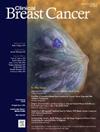激素受体和HER2在乳腺鳞状细胞癌中的预后分析:使用SEER数据库的匹配研究。
IF 2.5
3区 医学
Q2 ONCOLOGY
引用次数: 0
摘要
目的:探讨乳腺鳞状细胞癌(BSCC)与乳腺浸润性导管腺癌(BIDC)在受体亚型上的预后差异。材料和方法:我们从SEER登记处提取了2010年至2020年诊断为BSCC和BIDC的成年女性的数据。Kaplan-Meier曲线和log-rank检验评估生存差异。采用倾向得分匹配分析(PSM)对具有相似特征的被试进行匹配。Cox比例风险回归模型确定了生存预测因子。结果:与BIDC相比,BSCC患者年龄较大(60岁:60.6%比52.4%,P = 0.037), TNBC发病率更高(64.0%比12.2%,P = 0.001),转移率更高(48%比33.3%,P < 0.001)。BSCC患者的结婚率较低(44.6%比54.9%,P = 0.009)。BSCC患者的OS和CSS较差(P < 0.001)。在非tnbc中,BSCC在PSM前后的生存率较差(P < 0.05)。在TNBC中,BSCC的OS差于BIDC (P < 0.001),但PSM前的CSS相似。经PSM治疗后,无生存差异。分期是影响BSCC预后的重要因素(P < 0.001),而受体亚型无关(P < 0.05)。结论:与BIDC相比,BSCC在非TNBC人群中具有更高的TNBC发病率和更差的生存率。BSCC-TNBC患者的生存期与BIDC-TNBC相似。分期是BSCC的重要预后因素,比受体亚型更重要。本文章由计算机程序翻译,如有差异,请以英文原文为准。
Prognostic Analysis of Hormone Receptors and HER2 in Breast Squamous Cell Carcinoma: A Matched Study Using the SEER Database
Objective
To determine the prognostic differences between breast squamous cell carcinoma (BSCC) and breast infiltrating ductal adenocarcinoma (BIDC) by receptor subtype.
Materials and Methods
We extracted data from the SEER Registry for adult women diagnosed with BSCC and BIDC from 2010 to 2020. Kaplan-Meier curves and log-rank tests assessed survival differences. Propensity score matching analysis (PSM) was used to match subjects with similar characteristics. Cox proportional hazard regression models identified survival predictors.
Results
BSCC patients were older (> 60 years: 60.6% vs. 52.4%, P = .037), had higher TNBC incidence (64.0% vs. 12.2%, P = .001), and higher metastasis rates (48% vs. 33.3%, P < .001) compared to BIDC. Marriage rate was lower in BSCC patients (44.6% vs. 54.9%, P = .009). BSCC patients had worse OS and CSS (P < .001). In non-TNBC, BSCC showed poor survival before and after PSM (P < .05). In TNBC, BSCC had worse OS than BIDC (P < .001), but similar CSS before PSM. After PSM, no survival difference was observed. Stage was a significant prognostic factor for BSCC (P < .001), while receptor subtype was not (P > .05).
Conclusion
BSCC has a higher TNBC incidence and poorer survival in non-TNBC populations compared to BIDC. BSCC-TNBC patients have similar survival to BIDC-TNBC. Stage is a crucial prognostic factor for BSCC, more so than receptor subtype.
求助全文
通过发布文献求助,成功后即可免费获取论文全文。
去求助
来源期刊

Clinical breast cancer
医学-肿瘤学
CiteScore
5.40
自引率
3.20%
发文量
174
审稿时长
48 days
期刊介绍:
Clinical Breast Cancer is a peer-reviewed bimonthly journal that publishes original articles describing various aspects of clinical and translational research of breast cancer. Clinical Breast Cancer is devoted to articles on detection, diagnosis, prevention, and treatment of breast cancer. The main emphasis is on recent scientific developments in all areas related to breast cancer. Specific areas of interest include clinical research reports from various therapeutic modalities, cancer genetics, drug sensitivity and resistance, novel imaging, tumor genomics, biomarkers, and chemoprevention strategies.
 求助内容:
求助内容: 应助结果提醒方式:
应助结果提醒方式:


